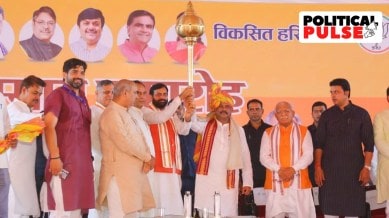Devansh Mittal is a trainee correspondent with The Indian Express. He studied political science at Ashoka University. He can be reached at devansh.mittal@expressindia.com. ... Read More
© The Indian Express Pvt Ltd

In a month’s time, Haryana will vote in the October 5 Assembly elections in what is expected to be a tight bipolar contest between the state’s ruling BJP and the Opposition Congress. Electoral data from the three elections held in the state over the last five years shows that the parties have drawn closer since the BJP’s sweep in the 2019 Lok Sabha polls, with more contests being decided by narrow margins and a decline in the average winning margins at the Assembly segment level.
2019 Lok Sabha polls
The BJP swept the Haryana elections, winning all 10 seats in the state, en route to getting 303 seats across the country. The party improved on its 2014 performance, when it had won seven seats, followed by the O P Chautala-led Indian National Lok Dal (INLD) at two, and the Congress at one.
Converted to the Assembly segment level, the 2019 Lok Sabha poll results put the BJP on top in 79 seats (out of the state’s total of 90). Not only that, the average victory margin of the BJP was an impressive 50,000 votes.
The Congress was ahead in only 10 Assembly segments, with the average margin between it and the second-placed parties at 32,000 votes. The Dushyant Chautala-led Jannayak Janta Party (JJP), which made its electoral debut that year after splitting from the INLD in 2018, was on top only in the Narnaund Assembly segment, where it led by 56,007 votes.
The average winning margin, across all parties, was 47,000 votes.
In other words, only a few Assembly segments saw tight contests, with the margin of victory less than 10% of the total votes in only 11 segments. The BJP won seven of these, the Congress three and the JJP one.
The Congress was the BJP’s main rival. In 73 of the 90 Assembly segments, the Congress finished as the runner-up. The BJP was the runner-up in all 11 of the segments in which it did not win, while the JJP was placed second in six segments.
2019 Assembly Elections
Held just five months after the general elections, the 2019 Assembly polls in Haryana saw the BJP fall from the highs of its Lok Sabha performance to short of the majority mark, amid a Congress resurgence. The BJP won 40 seats, six less than the 46-seat majority mark in the 90-member House. The Congress bagged 31 seats, the JJP 10, and the INLD one. The JJP proved to be the kingmaker, striking an alliance with the BJP to form a coalition government.
In the 2014 Assembly elections, the BJP had won comfortably to form its first government in Haryana.
In 2019, 47 seats – just over half of the total – were decided by a victory margin of less than 10% of the votes, making it a far more competitive election than the Lok Sabha polls. Of the 40 seats won by the BJP, 19 came in these tightly contested seats, while the Congress won 19 of these seats. The JJP won three such seats and the INLD one, with the remaining five going to Independents and minor parties.
In a considerable decline from the Lok Sabha polls that year, the BJP’s average victory margin fell to about 17,000 votes, while the Congress’s was 13,000. The JJP recorded the highest average victory margin in the 10 seats it won at just under 25,000 votes.
In a major reversal from the general elections, the BJP finished as the runner-up in 37 seats, followed by the Congress in 30 and the JJP in 10. In 13 other seats, minor parties and Independents were the runners-up.
2024 Lok Sabha elections
Five years later, the BJP fell from its record high seat tally in the 2019 Lok Sabha elections to 240 seats in all. In Haryana, the 10 Lok Sabha seats were divided evenly between BJP and Congress. Ahead of the polls, the BJP had snapped ties with the JJP, while the Congress and the Arvind Kejriwal-led Aam Aadmi Party (AAP) struck an alliance as part of the Opposition INDIA bloc.
Of the 90 Assembly segments, 33 were won by a victory margin of less than 10%, as opposed to just 11 in the 2019 Lok Sabha polls. The BJP won 17 of these, followed by the Congress at 13 and the AAP winning the remaining three.
This time, the BJP recorded an average winning margin of just over 25,000 votes in the 44 Assembly segments it won. Even in seats where it emerged victorious, the BJP’s margins were almost halved from 2019, suggesting that it not only lost in “weaker” seats, but also slid across the state.
The Congress, on the other hand, won 42 Assembly segments with an average victory margin of 30,000 votes, maintaining its victory margin from the 2019 Lok Sabha polls but across far more segments.
The BJP was the runner-up in all 46 Assembly segments it lost, while the Congress placed second in 39. The AAP was the runner-up in the five remaining segments.
Over the past five years, the median victory margin in the 30 most competitive races in the state has fallen drastically from a 13.3% vote share in the 2019 Lok Sabha elections to 3.84% in the 2024. While overall victory margins have reduced, it is worth noting that it is the BJP’s margins that have almost halved from 50,000 in 2019 to 25,000 in 2024, not the Congress’s, whose victory margins have remained stable at around 30,000.